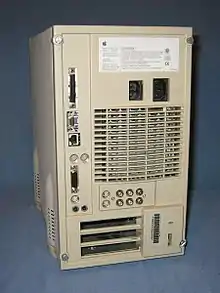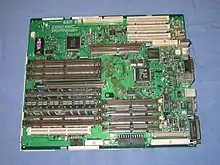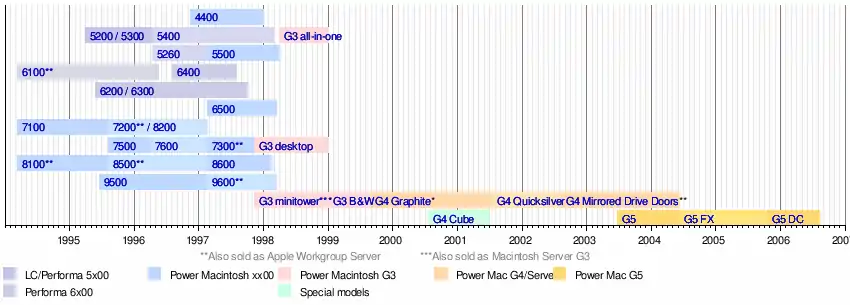Power Macintosh 8500
The Power Macintosh 8500 (sold as the Power Macintosh 8515 in Europe and Japan) is a personal computer designed, manufactured and sold by Apple Computer from August 1995 to February 1997. Billed as a high-end graphics computer, the Power Macintosh 8500 was the first Macintosh to ship with a replaceable daughtercard. Though slower than the 132 MHz Power Macintosh 9500, the first-generation 8500 featured several audio and video (S-Video and composite video) in/out ports not found in the 9500. In fact, the 8500 incorporated near-broadcast quality (640×480) A/V input and output and was the first personal computer to do so, but no hard drive manufactured in 1997 could sustain the 18 MB/s data rate required to capture video at that resolution. Later, special "AV" hard drives were made available that could delay thermal recalibration until after a write operation had completed. With special care to minimize fragmentation, these drives were able to keep up with the 8500's video circuitry.
 The Power Macintosh 8500/180 | |
| Developer | Apple Computer, Inc. |
|---|---|
| Product family | Power Macintosh |
| Release date | August 8, 1995 |
| Introductory price | US$3,999 (equivalent to $6,710 in 2019) |
| Discontinued | February 17, 1997 |
| Operating system | 7.5.2 - Mac OS 9.1 |
| CPU | PowerPC 604 or PowerPC 604e @ 120, 132, 150, 180, 200 MHz |
| Memory | 16 MiB, expandable to 512 MiB (Apple), 1024 MiB (actual), (70 ns 168-pin FPM or EDO DIMM) |
| Predecessor | Power Macintosh 8100 |
| Successor | Power Macintosh 8600 |
The 8500 was introduced alongside the Power Macintosh 7200 and 7500 at the 1995 MacWorld Expo in Boston.[1] Apple referred to these machines collectively as the "Power Surge" line, communicating that these machines offered a significant speed improvement over its predecessors. Infoworld Magazine's review of the 8500 showed a performance improvement in their "business applications suite" from 10 minutes with the 8100/100, to 7:37 for the 8500/120.[1] They also noted that the 8500 run an average of 24 to 44 percent faster than a similarly-clocked Intel Pentium chip, with the performance nearly double on graphics and publishing tasks.
The 8500's CPU was updated twice during its production run. It originally shipped with a 120 MHz PowerPC 604 CPU, later with the same chip running at 150 MHz, and finally with a PowerPC 604e running at 180 MHz. It was succeeded by the Power Macintosh 8600 in February 1997.
Models


Introduced August 8, 1995:
- Power Macintosh 8500/120[2]
Introduced January 11, 1996:
- Power Macintosh 8515/120[3]
Introduced February 26, 1996:
- Workgroup Server 8550/132[4]
Introduced April 22, 1996:
Introduced August 5, 1996:
- Power Macintosh 8500/180[7]
Introduced September 9, 1996:
Timeline of Power Macintosh models

References
- Epler, Anita (August 7, 1995). "Apple's PCI risk". InfoWorld Magazine. pp. 1, 80. Cite magazine requires
|magazine=(help) - "Power Macintosh 8500/120: Technical Specifications". Apple.
- "Power Macintosh 8515/120: Technical Specifications". Apple.
- "Workgroup Server 8550/132: Technical Specifications". Apple.
- "Power Macintosh 8500/132: Technical Specifications". Apple.
- "Power Macintosh 8500/150: Technical Specifications". Apple.
- "Power Macintosh 8500/180: Technical Specifications". Apple.
- "Apple Energizes Workgroup Servers and Network Servers with 200MHz PowerPC 604e Systems". Apple. September 9, 1996.
- "Workgroup Server 8550/200: Technical Specifications". Apple.
External links
| Wikimedia Commons has media related to Power Macintosh. |
- Power Macintosh 8500/120 at everymac.com.